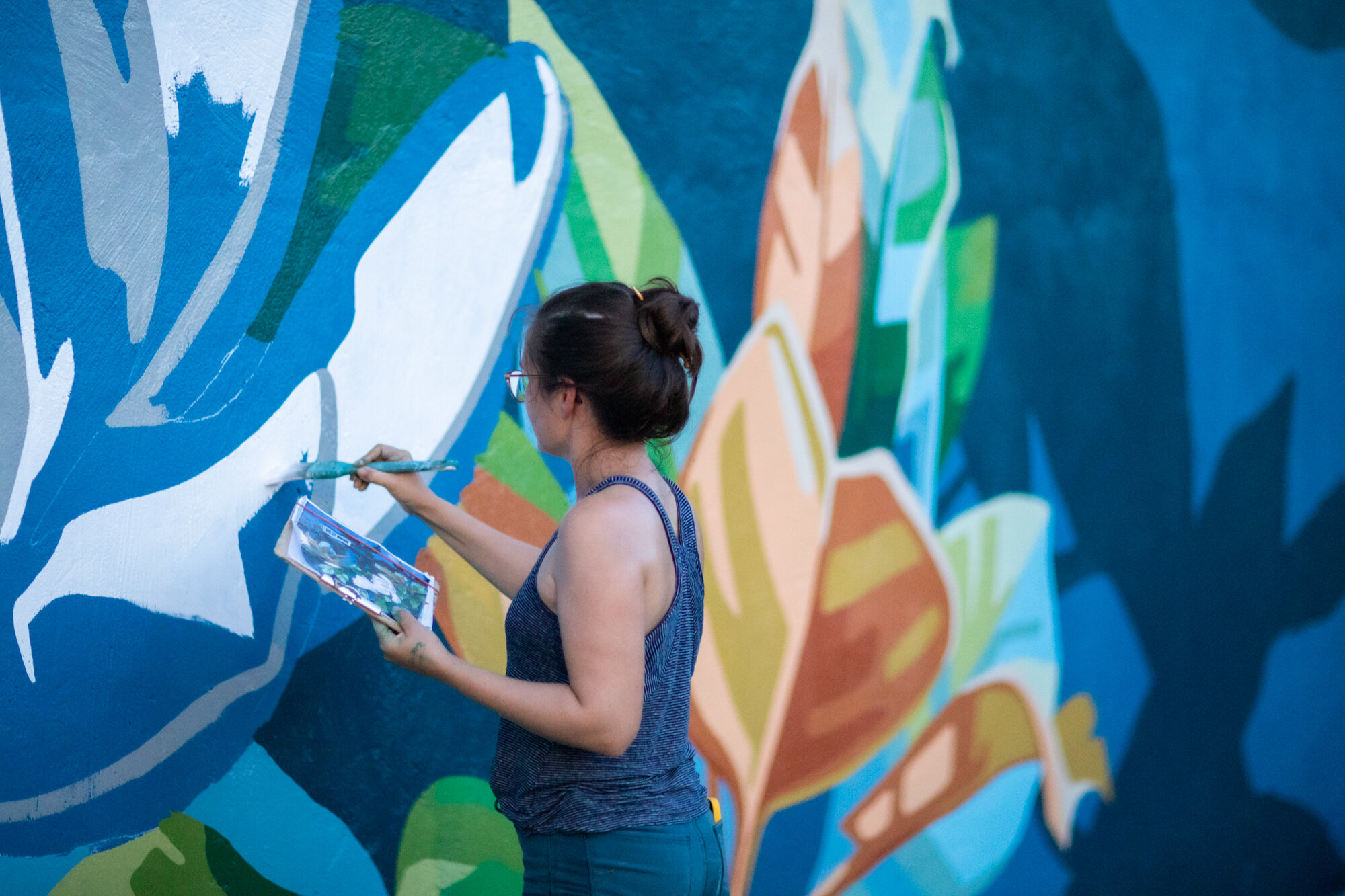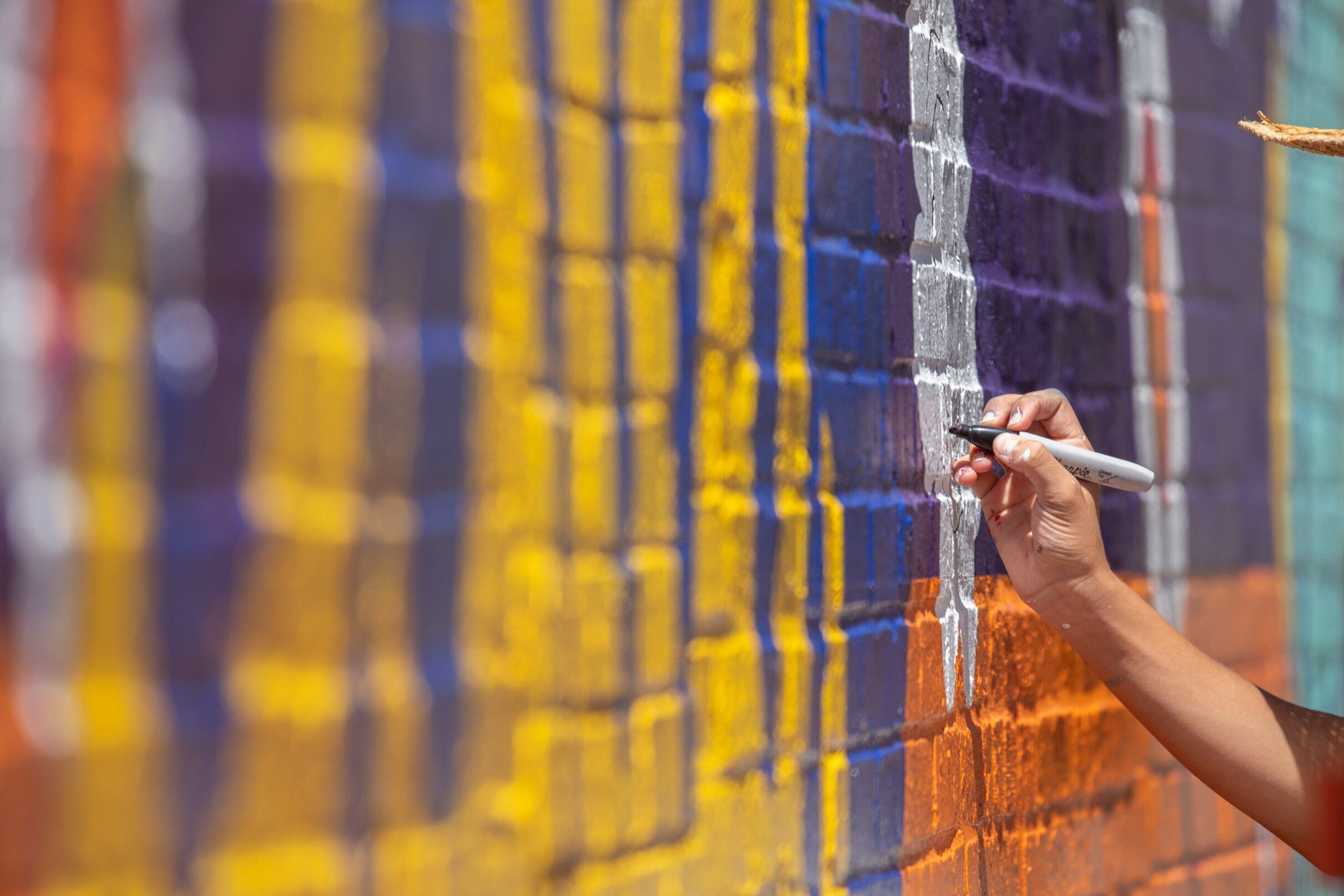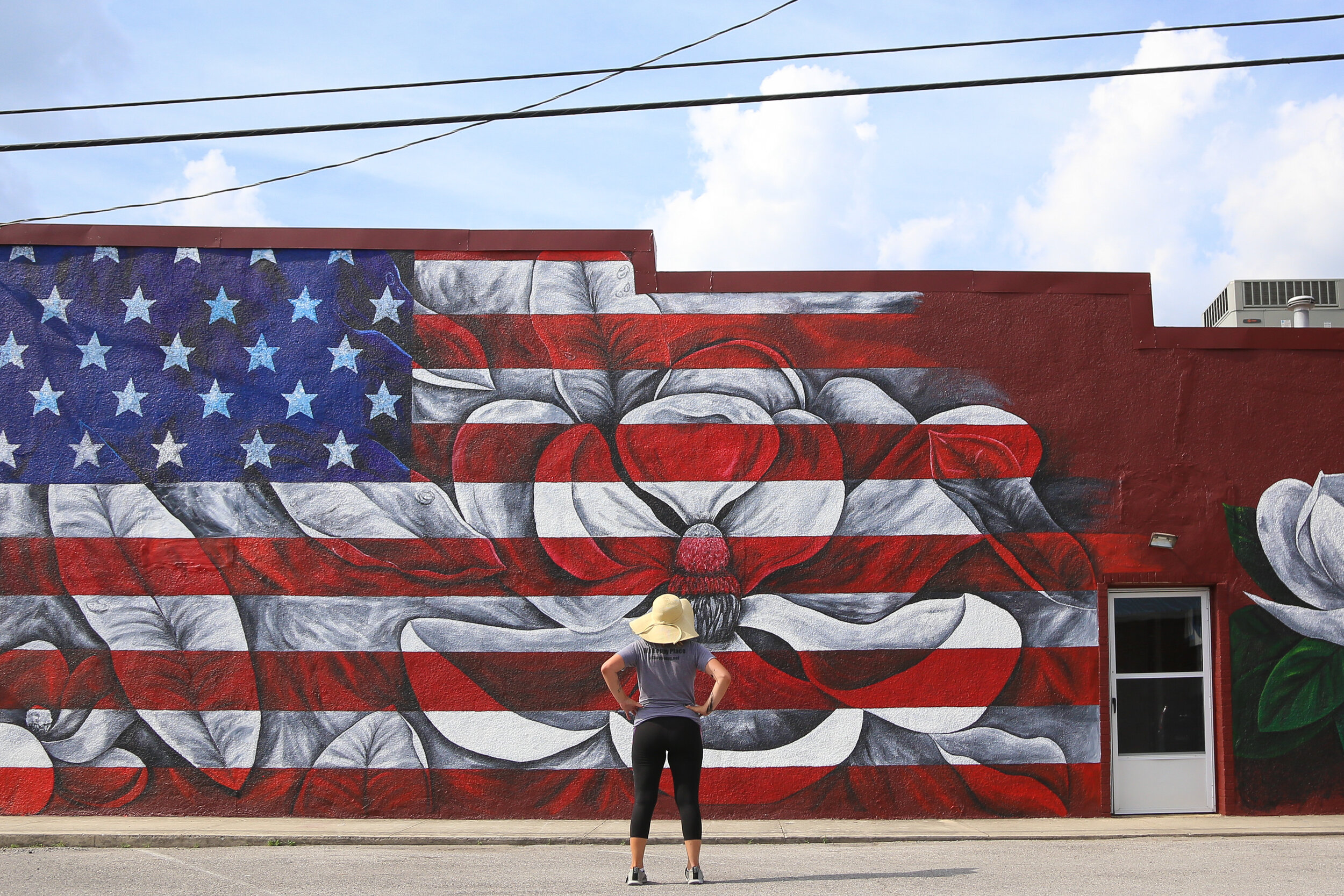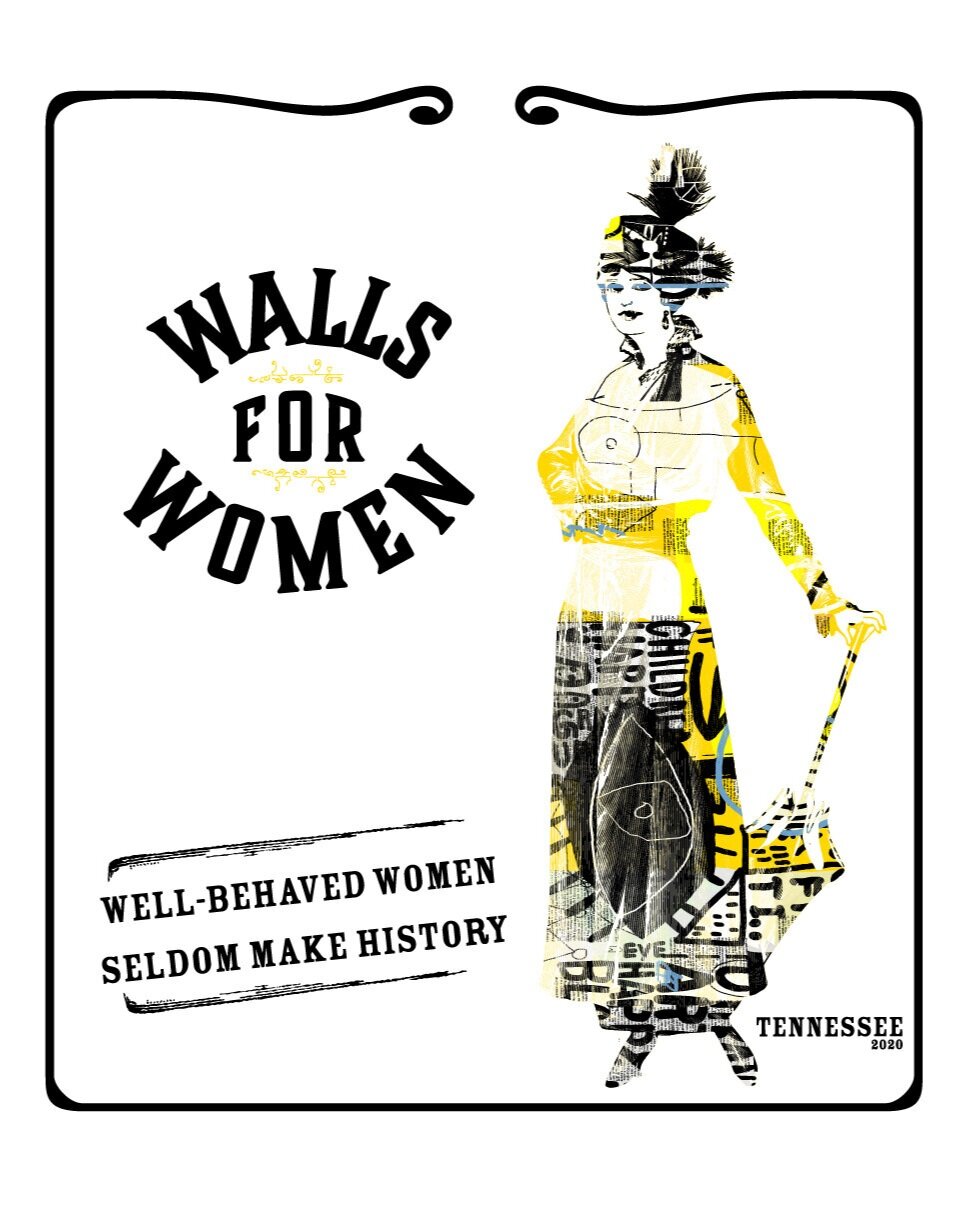
What is Walls for Women?
In 2020, we celebrated 100 years of women's suffrage and Tennessee's place in history in ratifying the 19th Amendment with the creation of original art throughout the state by an all-female team of professionals who comprised our first #WallsForWomen cohort of muralists.
In 2021 and beyond, we’re bringing even more art to rural communities. Want to be a part of the continuing conversation?
“Lady Justice” by Tara Aversa
Columbia, Tennessee
When tasked with coming up with a concept for Columbia, Tara Aversa chose to honor the strong women in her life, starting with her late grandmother, and spent the better part of a week in late-October and early-November painting through rain, wind and extreme cold.
“Lady Justice is dedicated to the Maurillo-Clavelli sisters—my grandmother Constance and her sisters who came over from Italy around a century ago,” she explains. “When I started working on the design for this mural, I wanted to include symbolic flowers for different people in my life who have passed on, then it turned out in the middle of painting it, Carmella—the last living sister—died suddenly,” continues Aversa, who was born in New York but spent most of her childhood in Murfreesboro. “Those women were so strong; a lot of my family takes up full streets in New York, where they immigrated to from Italy. We’re a tight-knit family with a bunch of strong, strong women, and I wanted to honor that bond and resilience in this piece.”
Lady Justice is located on Carmack Boulevard at East 13th St. in Columbia.
“Magnolia” by Megan Lingerfelt
Viola, Tennessee
Viola was once the smallest incorporated town in Tennessee—current census data has its population at 144—and Sara and Brian Covert, owners of Viola’s Pizza Co., wanted to bring art to their community, so they reached out about being a part of Walls for Women.
After a successful crowdfunding campaign led by the Coverts, we hired Oak Ridge-based artist Megan Lingerfelt to bring her touch of organic beauty to Viola. This piece took her three days, 24 shades of paint and her mother Jeanne as an assistant.
“A magnolia branch is a symbol of southern dignity and perseverance.,” Megan says. “The white blooms carry an inherent femininity and reference the white dress of the suffragettes.”
Magnolia is on the side of Viola’s Guest House on the Square in downtown Viola.
“This Girl Can” by Kim Radford
Sweetwater, Tennessee
DMA represented the Southeast in the National Endowment for the Arts’ women’s suffrage project and was awarded the grant on behalf of the region. After putting out a call for rural cities, we received more than two dozen applicants, and a panel of judges selected Sweetwater as a recipient due to its ties to the suffrage movement. Brown Intermediate School students voted on their favorite piece of art and selected Nashville-based artist Kim Radford’s rendering.
“The iconic goddess painted by master Italian painter, Botticelli in the 1480’s is the muse of my design. I wanted to recreate her in true pop art fashion by hyping her colors and scaling her head to fit a two-story building,” Kim explains. “Supporters of the women’s suffrage movement wore yellow roses. Purple, white and green were also colors of the movement, so I flooded my design with a suffrage palette. This Girl Can celebrates girls of all races, ages, and phases of their life.”
The women’s suffrage mural is located on Cleveland & Cleveland at the corner of Oak and Morris streets in downtown Sweetwater.
“This Girl Can” by Kim Radford
Nolensville, Tennessee
Nashville muralist Kim Radford created the final piece in the inaugural Walls for Women project as a sister wall for a mural she recently completed in Huntsville, Alabama. “Both are titled ‘This Girl Can’ and celebrate 100 years of women’s right to vote,” she says. “A lot has happened in 100 years, and I am so proud to have two murals that champion our gender!”
This Girl Can is located at 305 Sheldon Valley Dr. in Nolensville, Tennessee on the side of Mama’s Java.
“Punch Bug” by Whitney Herrington
Centerville, Tennessee
Artist and educator Whitney Herrington lives in Columbia, where she also has a studio downtown. When asked to be a part of Walls for Women, Whitney altered her original floral design after she saw the first few completed projects. “The other artists’ work was so in-tune to their individuality, so I decided to do a design that was reflective of me as an artist as well as me as an individual,” she says. “I have a 1974 VW Super Beetle named Alice ,and I based this design around her. This mural is 100 percent me and I am so pleased with the outcome.”
Punch Bug is located at 102 S. Public Square in Centerville, Tennessee on the courthouse square.

“Victoria” by Paris Woodhull
Knoxville, Tennessee
Her first outdoor mural, Knoxville-based illustrator Paris Woodhull painted this piece as a tribute to her ancestor Victoria Claflin Woodhull, famed suffragist and first woman to run for U.S. president. Paris’ art depicts a sense of harmony in a series of whimsical figures from all races dancing, hugging and making merry; many of them were born from the sketchbooks she’s doodled in over the years. “I want an even representation [of races and skin color], and I think that’s been my biggest move as an artist, too. I don’t want to make political art, but I want to make sure I am representing all different types of people,” she says. “I love the connection [to Victorian Claflin Woodhull], and that I get to create something that is so me for this project. I feel that in a small way that I am carrying on her legacy by doing what I love.”
Victoria is located at 1532 Island Home Ave. in Knoxville on the side of Printshop Beer Co.
“Senderos” by Nicole Salgar
Maryville, Tennessee
The brainchild of Miami muralist Nicole Salgar, Senderos spans 100 feet on a 35-foot-tall wall in Blount County. It took Nicole more than 100 hours to complete this installation in Maryville. “The woman in this mural is meant to portray a gatekeeper to other dimensions or realities. Her existence is one which flows through time without boundaries,” Nicole says. “The lock and key connect to gateways, or portals into the unknown, and they can also be interpreted as a way to unlock the hidden self. I intentionally set the woman in a range of misty mountains, since Maryville is situated in the beautiful Smoky Mountains. I wanted to capture the environment as if it were twilight when everything seems to be covered in a soft illuminating glow. Ultimately, this mural is a culmination of the maternal and feminine spirit of all things, being tied together through reality, dreams, space and time. A boundless energy which makes up the entire universe.”
Senderos is located at 601 E. Broadway Ave. in Maryville on the side of Bike N’ Tri.
“Miss Wynta-Amor” by Cymone Wilder + Sarah Painter
Nashville, Tennessee
This collaborative Walls for Women mural in Nashville was created by Nashville artist Cymone Wilder (lettering) and Florida muralist Sarah Painter (portraits), both of whom wanted to use women’s suffrage as a springboard into the larger conversation of women’s rights as a whole. Cymone: “I love that [the mural is] right next to the Jefferson neighborhood, which is one of the last Black communities in Nashville,” Cymone says. “For me, it felt like an important place to be ... One hundred years ago, women got the right to vote, but not all women got the right to vote. It hits both sides of that issue and points to some generational themes with the imagery as well.” Sarah adds: “This wall focuses on the intersection of sexism and racism and recognizes the fact that women of color have historically been excluded from feminist movements. this mural embraces the Black Lives Matter movement, [featuring] a portrait of seven-year-old Wynta-Amor Rogers protesting at a BLM march. I chose roses as a symbol of love and solidarity with women of color.”
Miss Wynta-Amor Rogers is located at 1414 Clinton St. in Nashville on the side of Nelson’s Green Brier Distillery.
“Wisteria Maiden” by JUURI
Tullahoma, Tennessee
Tokyo-born, Oklahoma-based artist JUURI painted the kabuki-style Wisteria Maiden on the backside of Memories Antiques in downtown Tullahoma as part of Walls for Women, honoring the Japanese prisoners held at Camp Forrest during World War II. “Tullahoma was one of the sites where Japanese (mostly US citizens) were interned during WWII. We Japanese are very steadfast and resilient people, and I’m sure that is how they got through this dark period,” JUURI says. “The Wisteria Maiden is an iconic Japanese symbol of a woman’s beauty. I loosely based my rendition on the Kabuki play version of her … her dance is mesmerizing. Wisteria blossoms also mean ‘welcome’ and ‘steadfast.’ I hope to cultivate these admirable traits during my lifetime.”
Wisteria Maiden is located on South Wall Street in Tullahoma right behind Memories Antiques.
“Hebe” by Jenny Ustick
McMinnville, Tennessee
Cincinnati-based artist and scholar Jenny Ustick chose to highlight McMinnville’s famed Hebe statue, as well as its roots in the nursery industry. “My design is four murals in one, with a breadth of style reflective of the beauty of collaboration and diversity of thought. The beloved statue of Hebe, goddess of youth and renewal, is emblematic of a collaboration between Mary Cunningham and Laura Davis Worley, who conspired to make life better for their hometown. Behind Hebe are the moon, the earth, and the waters of the Barren Fork and Collins rivers. A hand touches Hebe’s forehead as she projects her healing youthful strength across time and space. The hand is derived from an etching of Frances Wright, outspoken suffragist from the 1800’s. To the right of Hebe are crystalline forms derived from the saltpeter that was mined in the nearby caverns. I’m interested in the duality of it: used as an ingredient of gunpowder that fired guns in the civil war, saltpeter was also an essential ingredient of fertilizer that helped build the massive horticulture industry in the region; death and life, depending on how it is used. To the right of the crystal field are Tennessee purple coneflowers (aka echinacea), prized by the indigenous tribes that once populated the region, but also representative of the nurseries that make McMinnville the Nursery Capital of the World. Finally, on the right is an inverted illustration—white against a black background—of pecan leaves and drupes. This bookends the mural with multifaceted contributions to the history and industry of the city in which women played an important role. Judith Turner Harrison, who lived in the city’s famous Black House, collected rare plants and helped introduce horticulture to the area. She is credited with bringing the first cultivated pecan trees to the city. A slave in Louisiana known only as Antoine, who was an expert horticulturalist, developed a way to propagate individual pecan trees, making this transplantation possible.”
Hebe, the Moon, the Rivers, and the Land is located at 306 W. Main St. in McMinnville at the Security Federal Savings Bank complex.

“It was we, the people; not we, the white male citizens; nor yet we, the male citizens; but we, the whole people, who formed the Union ... Men, their rights and nothing more; women, their rights and nothing less.”
— Susan B. Anthony
WHY WOMEN, AND WHY ART?
Like nearly every profession, a gender gap exists in the art world: Women muralists are not afforded the same opportunities as their male counterparts. The street art scene in Tennessee is predominantly male, despite there being hundreds of female muralists every bit as talented. To commemorate 100 years of women having federally-recognized voting rights, we wanted to give female artists the chance to create and leave a piece of history behind. And our Walls for Women project turned out to be such a hit that we decided to make this program a pillar under our nonprofit.
TENNESSEE +
THE 19TH AMENDMENT
Were it not for a courageous woman named Phoebe Burn who talked her son into being the tie-breaking vote for the ratification of the 19th Amendment, who knows where women in this country would be today? We want to honor the bravery of every suffragist throughout the centuries through the creation of inspiring, unique and impactful art.













